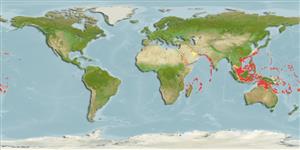Environment: milieu / climate zone / depth range / distribution range
Ökologie
seewasser riff-verbunden; tiefenbereich 5 - 350 m (Ref. 86942). Tropical
Indo-Pacific: Red Sea, Indonesia, Fiji, Samoa, and Tonga. Recently recorded from Reunion (Ref. 53568).
Size / Gewicht / Alter
Maturity: Lm ? range ? - ? cm
Max length : 45.0 cm TL Männchen/unbestimmt; (Ref. 48636)
Rückenflossenstacheln (insgesamt) : 4; Rückenflossenweichstrahlen (insgesamt) : 12 - 13; Afterflossenstacheln: 13. Recognized by the black first dorsal fin (Ref. 48636). Body with distinctive black spots. Respiratory valve inside lower jaw with a thread-like brownish appendage and several long filaments around is base. Upper edge of opercle ascending backward. Posterior nostril a slit-like pore or with a very low tubular valve. First dorsal fin with V spines (last one rudimentary). Only 1 basipterygial process. No cirrus on eye (Ref 42788).
Inhabits reef flats and coastal bottoms (Ref. 9710) but is rarely seen because it lies buried in sand or mud most of the time, with only the eyes showing. When buried, the cirri on the edge of the mouth serve to keep out the sand during respiration. The oral lure is used to attract the prey within striking range of the mouth. The shoulder has a venomous cleithral spine; wounds can be serious.
Life cycle and mating behavior
Geschlechtsreife | Fortpflanzung | Ablaichen | Eier | Fecundity | Larven
Randall, J.E., G.R. Allen and R.C. Steene, 1990. Fishes of the Great Barrier Reef and Coral Sea. University of Hawaii Press, Honolulu, Hawaii. 506 p. (Ref. 2334)
IUCN Rote Liste Status (Ref. 130435: Version 2024-1)
Bedrohung für Menschen
Traumatogenic
Nutzung durch Menschen
Tools
Zusatzinformationen
Download XML
Internet Quellen
Estimates based on models
Preferred temperature (Ref.
123201): 26.9 - 28.1, mean 27.4 °C (based on 56 cells).
Phylogenetic diversity index (Ref.
82804): PD
50 = 0.5000 [Uniqueness, from 0.5 = low to 2.0 = high].
Bayesian length-weight: a=0.00794 (0.00322 - 0.01959), b=3.09 (2.89 - 3.29), in cm total length, based on LWR estimates for this Genus-body shape (Ref.
93245).
Trophic level (Ref.
69278): 4.1 ±0.70 se; based on food items.
Widerstandsfähigkeit (Ref.
120179): mittel, Verdopplung der Population dauert 1,4 - 4,4 Jahre. (Preliminary K or Fecundity.).
Fishing Vulnerability (Ref.
59153): Low to moderate vulnerability (35 of 100).
